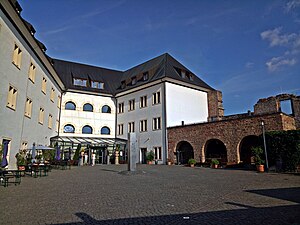Altleiningen Castle
| Altleiningen Castle | ||
|---|---|---|
|
Core area of the castle: today a youth hostel, ruins on the right |
||
| Creation time : | around 1100 to 1110 | |
| Castle type : | Höhenburg, spur location | |
| Conservation status: | Received or received substantial parts | |
| Standing position : | Count | |
| Place: | Altleiningen | |
| Geographical location | 49 ° 30 '41.8 " N , 8 ° 4' 57.1" E | |
| Height: | 400 m above sea level NN | |
|
|
||
Altleiningen is a castle in the Palatinate Forest . It is located in the district of Altleiningen in the Bad Dürkheim district in Rhineland-Palatinate .
Geographical location
While the municipality of Altleiningen extends at 300 meters above sea level in the valley along the Eckbach , the Höhenburg was built on the top of a 400 meter high mountain that rises above the left bank of the Eckbach.
history
As with the sister castle Neuleiningen , located five kilometers to the northeast, the name is derived from the Franconian noble lineage of the Leininger , who previously owned the Leiningerland .
The mighty mountain fortress is built on rocks and was probably built by the Leiningen counts Emich I and his son Emich II around the period from 1100 to 1110, at that time under the name Burg Leiningen . The entire castle complex, following the shape of the hilltop, formed a triangle in plan. A few remains of the wall on the west side still tell of the original building. The outer bailey was surrounded by its own moat and separated from the actual castle by a main moat carved into the rock, over which a drawbridge led. Two kilometers south of the castle, Emich II founded the Höningen monastery around 1120 .
The first destruction took place in the peasant uprising of 1525. The current complex is based on the reconstruction in the Renaissance style from 1528 by the Counts Cuno II , Philip I , Ludwig and Johann Casimir . The farmers in the area had to do labor for the restoration .
Around the year 1600 a tunnel was driven deep into the rock below the castle to supply water . The 20-tube well fed from the tunnel is now the Eckbach's strongest water supplier.
In 1690 the castle was destroyed for the second time and finally by French troops during the War of the Palatinate Succession . It then served as a quarry until the middle of the 19th century, until the government of the Kingdom of Bavaria forbade this removal. The grounds remained in the possession of the Counts of Leiningen (Leiningen-Westerburg-Altleiningen line) until 1933, before the then Frankenthal (Palatinate) district acquired it. In 1962 the ruin was placed under a preservation order and the castle wing was rebuilt in the following six years, including the remaining remains of the wall, in particular the striking, widely visible palace wall with three storeys of windows in the southeast.
Todays use
leisure
In 1968, a youth hostel was integrated into the castle, which was only partially rebuilt, and was completely modernized between 1998 and 2000. During this renovation, the castle was given a gable roof again ; previously she had had a simple flat roof in the style of the 1960s. The knight's hall is used as a dining room; Another guest room is the Burgschänke with a summer terrace. The main moat was converted into a public outdoor pool .
Culture
The roofed “Hall of Honor”, a room separated from the castle courtyard by arcades, offers seating for around 250 visitors. Since 1980 the amateur theater of the Burgspiele Altleiningen has been performing challenging plays every year in the summer months. These are both classic and modern, and often - because of the appropriate ambience - those with historical references.
nature
The largest population of wild bats in Germany is in the vaults of the castle cellar . For reasons of biotope protection , however, no access for visitors is possible.
gallery
literature
- Jürgen Keddigkeit , Alexander Thon, Karl Scheurer, Rolf Übel : Palatinate Castle Lexicon, Volume 1: AE . 2nd Edition. Institute for Palatine History and Folklore, Kaiserslautern, Kaiserslautern 2003, ISBN 3-927754-51-X , pp. 131–147.
- Hans Heiberger: 1200 years of Altleiningen. 780-1980 . Heidelberger Verlagsanstalt, Heidelberg 1980.
- Hans Heiberger: The Counts of Leiningen-Westerburg. Origin, splendor, decline . Kiliandruckerei Dinges, Grünstadt 1983, ISBN 3-924386-00-5 .
- Alexander Thon (Ed.): How swallow nests glued to the rock. Castles in the Northern Palatinate . 1st edition, Schnell and Steiner, Regensburg 2005, ISBN 3-7954-1674-4 , pp. 22-25.












